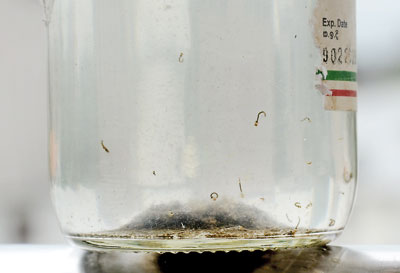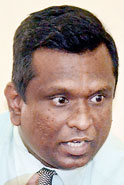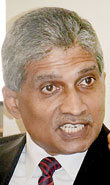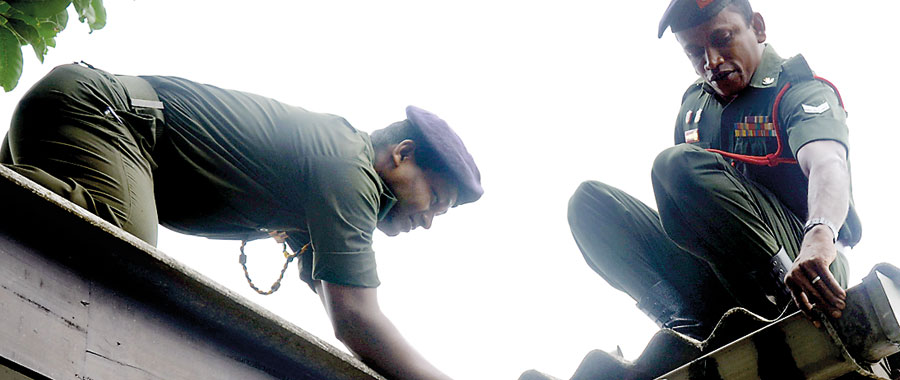News
Big MCs need more money to fight dengue: Kesarralal
The woes of the local government bodies in their Herculean task of dengue prevention came to the fore this week as rains lashed the country and the public continued to nurture mosquito breeding sites. Trapped in the lowest rung of the three-tiered structure of central government, provincial councils (PCs) and local-government bodies, the flow of funds and resources from the top is problematic to the local authorities which include 335 Municipal Councils (MCs), Urban Councils (UCs) and Pradeshiya Sabhas (PSs), it is learnt.

Larvae picked up from breeding spots in homes. Pix by Hasitha Kulasekera
“The funding is channelled through the Western Provincial Council and there is much delay. The central government only provides the salaries for the cadre employed by the Dehiwela-Mount Lavinia Municipal Council (DMMC), but even from that money, about 10-15% is delayed by the PC and released for a technical project at the last minute when the year is ending,” lamented Deputy Mayor Kesarralal Gunasekera.
“From where can we get cash for capital expenditure and overtime payments, lunch allowances etc.?” he asked, pointing out that when you take staff on field assignments you cannot ask them to buy their lunch at that site. Claiming that the rates collected from residents are just a drop in the ocean of expenditure, he said even the court fines and stamp fees which amount to millions and should come to the council are delayed by one and a half years.
While conceding that local councils have a major role to play in dengue prevention and control but the people have an equally important or higher responsibility, the Deputy Mayor reiterated that there is a lack of funding and resources.The DMMC is the second largest Municipal Council in the country, after the Colombo Municipal Council, with an estimated population of nearly 200,000 and a floating population of another 50,000 in an area of 21.4 sq. km. There are 85,000 properties including 37 schools under the mandate of the DMMC which covers the two Divisional Secretariat Divisions of Ratmalana and Dehiwela.
Pointing out the problems that assail dengue work, Mr. Gunasekera said that the DMMC with such a large number of properties under it has only 11 Public Health Inspectors (PHIs), five from the Health Ministry and the others from the provincial health authority. They are supervised by the Chief Medical Officer of Health (MOH), Dr. Indika Ellawala and three Additional MOHs.
It was impossible for the PHIs to check all the properties, the Deputy Mayor said, pointing out that a single PHI might be able to look at 100 houses or establishments a day. Dengue work, according to him, is not limited to just a few meetings, but is carried out throughout the year. The DMMC’s dengue unit conducts not only daily programmes in different areas but also major weekly programmes.
Yet the problem is getting aggravated as there is an attitudinal issue among the public that it is not their business but that of the authorities. The war against dengue can be won only if people change their attitudes and clean up their homes, gardens and surrounding areas daily, Mr. Gunasekera said.

Chief MOH Dr. Indika Ellawala
When asked about the garbage collection and disposal crisis that the people living in the DMMC area are complaining about, the Deputy Mayor said the council has to pay on average a huge Rs. 36 million per year to the Waste Management Authority, an expenditure that was not there earlier. “This sum is what they have stipulated and not what has been negotiated with us. We can’t do anything, we have to pay up.”

Deputy Mayor S.V.D. Kesarralal Gunasekera
“How can we find the money,” he asked, adding that whenever there is a move to increase the rates charged from the people there is an outcry. The two prongs of the garbage issue are the large amount of garbage, almost 190 tons a day that are generated in the area and the dearth of drivers for the collection trucks.
“We need at least 50 vehicles to ply the streets daily,” Mr. Gunasekera said. “In the past eight years, the DMMC had bought only six new vehicles while some of the vehicles that are in use are more than 25 years old. This year, we have bought 12 new vehicles, augmenting the fleet to 69, but that is after negotiating a massive loan. We just do not have the money to replace the ramshackle trucks. The shortage of drivers though has not been addressed yet as cadre increases and wages have to be approved by the central government and channelled through the Western PC.”
The deputy mayor said the Finance Commission should allocate some funds directly to the local bodies and not through the PCs for certain expenditures. Pointing out the crucial role played by local councils in the lives of the citizen, he said the municipal council takes care of everything from birth to death.
Urging the strengthening of the local government bodies, he suggested that a system should be implemented to categorise the 335 MCs, UCs and PSs into five groups, with each group being infused with essential funding of around Rs. 25-100 million every five years.
Large councils would need more money and smaller ones less. This would help alleviate the problems faced by the struggling local government bodies in their bid to provide a better service to their rate-payers, he added.
Sleeping with the enemy: Killer mosquito lurks in your home
Taken on a dengue inspection at Mihindu Mawatha in the Dehiwela-Mount Lavinia area, the Sunday Times sees first-hand the lethargy and disinterest of the people in cleaning up even the immediate environs around their homes.

Dengue checks down Mihindu Mawatha in the Dehiwela-Mount Lavinia area
In one large up-stair home where a young couple is living with a toddler, the garden is strewn with numerous toys, containers and even discarded plastic chairs with collections of water, which would beckon the female dengue mosquito to come lay its eggs.When asked whether they are not aware of the deadly threat of dengue, they smile and say they are but their actions of harbouring so many breeding spots indicate that the flood of prevention messages has not hit home.
Just opposite this house is a locked-up property. A peek through the gate reveals similar stuff, ideal breeding spots for mosquitoes, littering the garden and the verandah. The DMMC’s anti-dengue unit is then gripped by frustration. The team comprises a PHI, Environmental Police, Army and Air Force personnel, trained staff from the provincial health dengue unit, trained DMMC labourers and officials from the Divisional Secretariat.
The security forces help out in the battle against dengue, says Chief MOH, Dr. Ellawala, as we walk into another garden of an elderly couple. Everywhere is a mosquito breeding area, from the broken down gutters, a disused toilet, buckets strewn around, cemented areas in the garden with small dips in them and the heavy foliage to the un-cleared fridge-tray.
Realising the sad plight of the elderly couple, the team tells them of the gravity of the situation and cautions them that if the place is not cleaned up in three days, action will be filed against them. Stressing that whenever a suspected dengue patient goes to a state hospital, such as the Kalubowila Hospital the notification to the MOH is immediate through email, he says that among the private hospitals only Lanka Hospital uses this system. All other private hospitals send the notification through the post and that too only after the patient has been discharged. This takes awhile to reach the MOH.
Once the bulk -mail notification from state hospitals reaches the MOH, an officer goes through it and selects those which come under the DMMC. Thereafter, the relevant PHI is notified and mopping-up activated within three days.
“Such mopping up operations have revealed that in almost 80% of cases, the dengue source is in the house of the patient,” says Dr. Ellawala, adding that one case leads to a pocket of cases. We clear the pocket before the situation gets out of hand.
Follow @timesonlinelk
comments powered by Disqus

